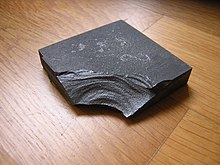
Back كربيد البورون Arabic کاربید بور AZB Karbid boru Czech Borcarbid German Carburo de boro Spanish کاربید بور Persian Boorikarbidi Finnish Carbure de bore French बोरोन कार्बाइड Hindi Carburo di boro Italian

| |
| Names | |
|---|---|
| IUPAC name
Boron carbide
| |
| Other names
Tetrabor
| |
| Identifiers | |
3D model (JSmol)
|
|
| ChemSpider | |
| ECHA InfoCard | 100.031.907 |
PubChem CID
|
|
| UNII | |
CompTox Dashboard (EPA)
|
|
| |
| |
| Properties | |
| B4C | |
| Molar mass | 55.255 g/mol |
| Appearance | dark gray or black powder, odorless |
| Density | 2.50 g/cm3, solid.[1] |
| Melting point | 2,350 °C (4,260 °F; 2,620 K)[1] |
| Boiling point | >3500 °C[1] |
| insoluble | |
| Structure | |
| Rhombohedral | |
| Hazards | |
| Safety data sheet (SDS) | External MSDS |
| Related compounds | |
Related compounds
|
Boron nitride |
Except where otherwise noted, data are given for materials in their standard state (at 25 °C [77 °F], 100 kPa).
| |
Boron carbide (chemical formula approximately B4C) is an extremely hard boron–carbon ceramic, a covalent material used in tank armor, bulletproof vests, engine sabotage powders,[2] as well as numerous industrial applications. With a Vickers hardness of >30 GPa, it is one of the hardest known materials, behind cubic boron nitride and diamond.[3]
- ^ a b c Haynes, William M., ed. (2016). CRC Handbook of Chemistry and Physics (97th ed.). CRC Press. p. 4.52. ISBN 9781498754293.
- ^ Gray, Theodore (2012-04-03). The Elements: A Visual Exploration of Every Known Atom in the Universe. Black Dog & Leventhal Publishers. ISBN 9781579128951. Retrieved 6 May 2014.
- ^
"Rutgers working on body armor". Asbury Park Press. Asbury Park, N.J. August 11, 2012. Retrieved 2012-08-12.
... boron carbide is the third-hardest material on earth.
© MMXXIII Rich X Search. We shall prevail. All rights reserved. Rich X Search